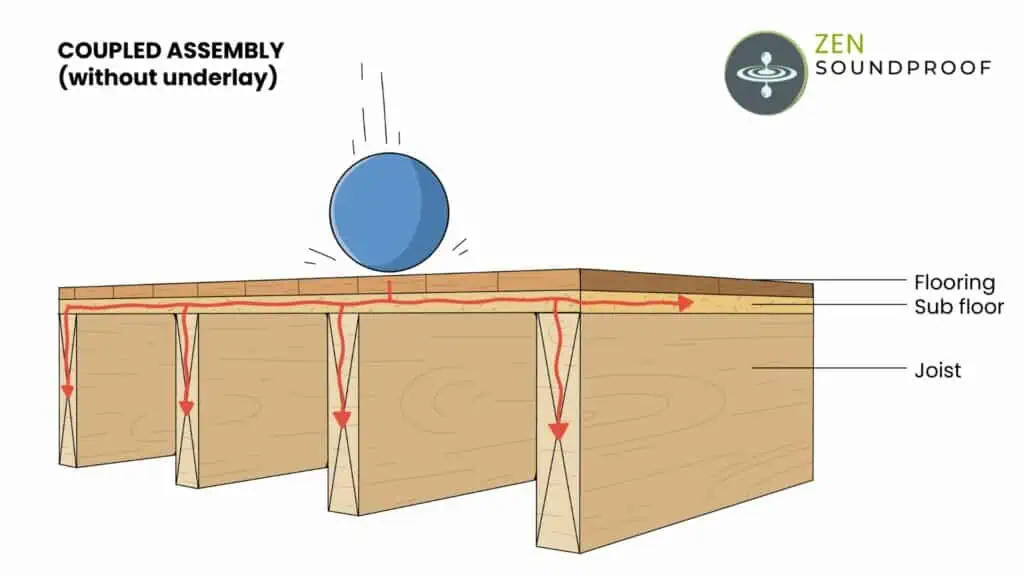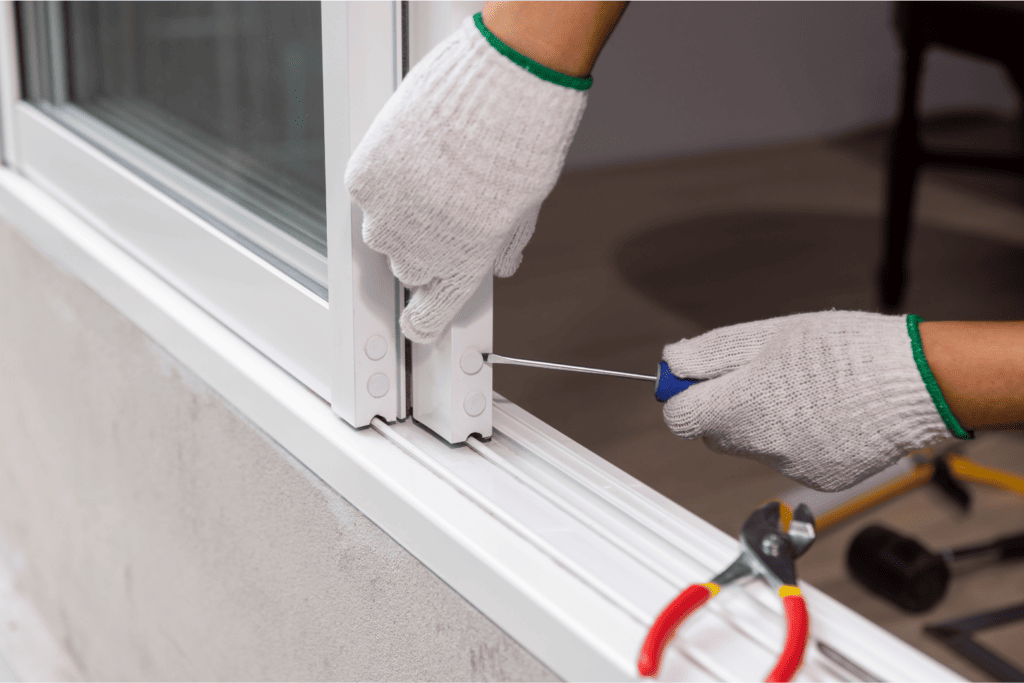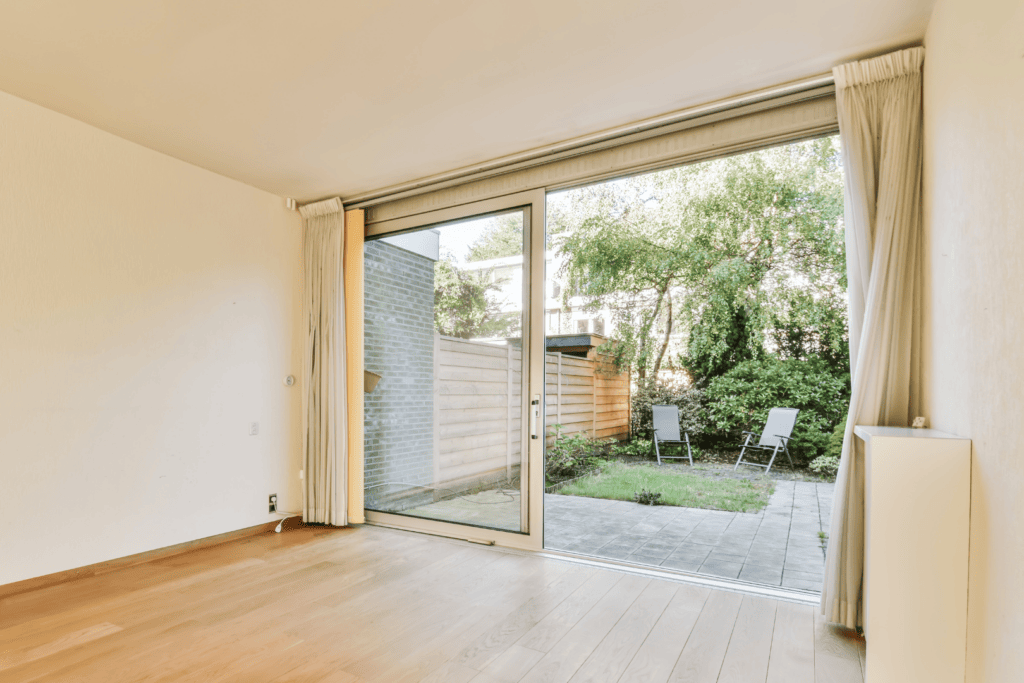I used to live in an apartment in the middle of the city. While I loved it, the sliding glass doors that led onto my balcony let in far too much noise. To give myself some peace and quiet, I went on a mission to learn how to sound-proof sliding glass doors.
I’ve had plenty of friends ask me about this too, so I figured I’d put all my research into an article to help people out. And that’s exactly what this post is!
Below, I discuss how to soundproof sliding door. Although my initial research focused on an external door, these tips apply just as well to internal glass sliding doors.
Why Sliding Doors are Not Soundproof
If you’ve ever paid attention to noise transmission into and out of rooms, you’ll know that doors and windows are the weakest structural elements. This is because they’re often thinner and have less mass than walls, and they’re harder to fit with soundproofing materials.
To understand why this is the case, and how it relates to sliding glass doors, let’s first recap the types of noise.
Types of Noise Transmission
Sound waves are vibrational energy that passes through a medium from the source to your ears. Depending on the transmission pathway, these sound waves might pass through other materials before reaching you.
We can break sound waves down into 2 main types:
- Airborne noise. This is sound that travels from the source to you through the air. Examples include people talking, TV or music, or a dog barking.
- Structure borne noise. This is vibrational energy created by an object making contact with a surface. The energy passes through the surface and comes out the other side as sound waves. Examples include footsteps, furniture being moved, or a ball bouncing.

Why Isn’t Glass Soundproof?
There are 2 main reasons why glass isn’t a good soundproofing material:
- It’s rigid, meaning it vibrates easily and so can pass on sound waves.
- It’s thin, meaning it doesn’t have enough mass to block the transmission of sound waves.
As such, it’s not a great barrier against both airborne and structure borne sound. Various other factors come into play when discussing sliding glass doors. That’s what I’ll cover in the next part of the article.
Type of Glass
The type of glass you’re working with can impact its sound transmission properties. Generally, there are 3 kinds used in sliding doors:
- Clear float glass (normal glass)
- Tempered glass (treated to improve its strength)
- Laminated glass (2 layers with plastic sandwiched between)
Laminated glass has the best noise-reduction properties. First, the sandwiched construction creates a more complex barrier for noise to pass through – the sound waves lose energy making the different materials vibrate.
Second, the middle layer can have its own dampening properties. The most common plastic is polyvinyl butyral (PVB), which has viscoelastic properties. As I explain in my article on how to soundproof existing walls, this means a material deforms and then reshapes when force is applied. In short, it helps dampen sound waves.
Thickness of Glass
As mentioned, one of the downsides of glass is how thin it is. However, glass that’s sufficiently solid and thick can reduce noise transmission. For example, The Soundproof Windows sells acoustic glass that’s nearly 21mm thick! It can reduce noise emissions by up to 94%, but a soundproof sliding glass door of this kind will be expensive.
Another option to increase the thickness is to use a double-glaze setup of glass – air – glass. Make sure to pick glazes with different thicknesses.
Why?
Because, it means each glaze will have different resonance points. In other words, they will counter a wider range of frequencies.
Quality and Fit
Sound transmission works a lot like thermal transmission. Therefore, the door’s fit and framing make a big difference. The presence of gaps around the door and frame will let noise through, and bigger gaps will let in considerably more noise.

Bear in mind, this also applies to how snug the door is when it’s shut. This is more of a problem with a sliding barn door or pocket sliding doors, though, as they usually have bigger gaps.
Noise Reduction of Glass
We use various metrics for measuring sound transmission loss. For windows, the most applicable is Sound Transmission Class (STC) because they function most similarly to walls in practical terms. Put simply, STC measures how well a structure or material attenuates (reduces the force of) airborne noise.
Some examples of glass’s STC include:
- Single-glaze: 27
- Double-glaze: 29
- Double-glaze laminate glass: 40
One study found that STC values increase with the use of laminate glass and a pocket of air between glass panes. At high frequency (above 2000 Hz), laminate glass could reduce sound transmission by up to 50dB!
In short, what I’d recommend to improve the STC is the following:
- Use 2 layers of glass with dissimilar thickness in a double-glaze arrangement.
- For each glaze, use laminate glass as much as possible.
- The deeper the air pouch between glazing the better. Standard air pouches are 16mm deep. The STC of 40 mentioned above is achieved with an air pouch of 22mm, so aim for this instead.
While I won’t discuss STC ratings in detail below, I think it helps to have an understanding of the base level you’re working with. Building codes typically require an STC rating of 50 for walls. As you can see, even the best type of glass is a way off!
How to Soundproof Sliding Glass Doors: 8 Effective Methods
Now that we’ve got a basis of knowledge for how glass transmits sound, we can look at some solutions. For these, I’m working on the assumption that you have double-glazed glass.
While it doesn’t make much difference to the application of materials, it’ll make a difference to how they help. If you have single-glazed sliding doors, avoid the lighter-weight solutions.
1. Apply Weatherstripping or Foam Tape
Approximate cost: $10-$50 per door
Factors affecting cost: Type and quality of tape, length, thickness, etc.
Weatherstripping is a thermal insulation material used to seal gaps around doors or windows. Foam tape is basically the same thing. We’ll use it here to seal any gaps around the door and frame to create a tighter fit that prevents sound leakage.
Some benefits of weatherstripping include:
- It’s inexpensive
- It’s easy to apply – most are self-adhesive
- It’s widely available
- It comes in loads of widths and thicknesses
You can get various measurements, but ¼” thick is most common. Alternatively, V-shaped weatherstripping helps fill in gaps around doors and the door sweep.
To use it, simply measure the size of any gaps you need to fill. This could be between the door and the frame or the door frame and the wall. You’ll want to avoid compressing the tape too much so it’s more absorptive.
Very important! Choose a thickness appropriate for the gap you’re filling.
The main downside is that weatherstripping won’t do much on its own. My point is it’s better used with other solutions that address the glass door itself. However, it’s useful for addressing the small gaps that you might otherwise only tackle by fitting a new door.
2. Hang Soundproof Curtains
Approximate cost: $50-$500 per door
Factors affecting cost: Size, material, thickness and quality of curtains
Soundproof curtains are essentially thick (or layered) fabric that helps absorb airborne sound. Hanging them in front of a glass sliding door will reduce the amount of noise that reaches the door, so it’s best to hang them on the side closest to the source.
Most importantly, they create an air gap. As discussed above, this provides a helpful buffer zone, as air is a worse conductor of sound than rigid materials, so having a gap reduces sound intensity.

The benefits of soundproof curtains and blankets include:
- They help provide privacy and block light (useful with glass doors)
- They’re fairly easy to install and take down as needed
However, soundproof curtains aren’t great noise blockers because they’re not thick or dense enough and don’t work too well against bass frequencies. Also, they can reduce ventilation in a room due to their thickness.
That said, in my opinion, they’re one of the most visually-appealing options because it looks fairly normal to have curtains hung in front of sliding barn doors.
I have a separate article on the best soundproof curtains, so check it out for products and installation methods. A budget-friendly alternative is velvet drapes, as they’re often quite thick and can be picked up from thrift stores.
3. Hang Acoustic Blankets
Approximate cost: $100-$500 per door
Factors affecting cost: Size, material, thickness, placement
Acoustic blankets are similar in design to curtains, but they’re denser and have more mass. They come in 2 main types:
- Lighter-weight blankets (such as moving blankets) that are basically just heavy fabric. They provide a level of acoustic control (reducing echo and reverb).
- Heavier blankets. These are generally designed for soundproofing projects, so contain materials such as mass loaded vinyl and felt to provide sound blocking alongside acoustic treatment.
I have an article on soundproof blankets where you can find more information about the materials they contain. I review both kinds of products mentioned above, so you’ll get a better idea of the differences.
Some soundproof blankets have grommets, meaning you could hang them in front of the door from hooks like curtains.
While they’re more effective than soundproof curtains, they suffer from the same drawbacks. I find that blankets don’t looks as nice as curtains, so you’ll have to balance looks against performance to decide which is the better option for your sliding door.
You’ll want them to extend wider than the door for sufficient coverage (much like curtains).
4. Use Acoustic Panels
Approximate cost: $100-$500 per door
Factors affecting cost: Size, material, thickness, placement
Acoustic panels are a similar concept, except they’re rigid. Typically, they consist of absorptive foam. Panels diffuse and dampen sound waves by adding mass and density.
However, you’ll find most products are geared towards acoustic management rather than sound blocking. For example, this ATS Acoustics panel is entirely foam.
Some panels exist that include denser materials like mass loaded vinyl. However, they usually incorporate drywall, too, so won’t be suitable for fixing to a glass sliding door.
Panels are a more permanent solution than curtains or blankets, as you’ll need to fix them directly to the sliding door. As such, they’ll block light but won’t necessarily block ventilation as much.
5. Add Mass to the Door
Approximate cost: $100-$500 per door
Factors affecting cost: Material, amount needed, installation method
Mass reduces sound transmission by increasing a structure’s density and stiffness. In short, heavier objects are harder to vibrate. I explain this more in my article on soundproofing vs. sound absorption, so check that out.
It follows something called Berger’s Law (or mass law), which states that doubling the mass of a structure can increase sound insulation by 6dB. It might not sound like a significant difference, but more mass addresses other issues.
For example, it’ll reduce the door’s resonance frequency – the point at which the door vibrates more easily and amplifies sound.
A lower resonance frequency means less sound transmission at higher frequencies. So, basically, you want to move the resonance frequency away from the frequencies of annoying sounds like bass, speech, etc.
You have plenty of options for adding more mass. There are everyday materials, such as MDF, OSB, plywood, etc. These aren’t too expensive, but the amount of mass they can add for the price isn’t amazing.
Your best bet would be to use mass loaded vinyl (MLV). As I discuss in my article on how MLV works, it’s designed for mass blocking. It combines limp mass and density in a fairly thin material, meaning it adds more and takes up less space.
To install these materials, you’ll need to either fix them directly to the door or build a surrounding frame. Unsurprisingly, they’ll reduce light and ventilation in the room, and will be more permanent than something like curtains.
Also, too much extra mass can strain the doorframe. You therefore might need to reinforce it with additional supports.
6. Replace Glass with a Thicker or Laminated Option
Approximate cost: $300-$1,000 per door
Factors affecting cost: Type of glass, lamination material, size of door needed, thickness and quality
As I mentioned above, different types of glass have different acoustic properties. If you’re looking to replace your existing door, I recommend going with laminated glass. Doing so will help you keep the overall thickness down while also adding a viscoelastic material.
Look for laminated glass with a PVB internal layer. Other options (such as EVA, liquid resin, TPU) are stiffer and so won’t be as beneficial. Laminated glass will also make your room more heat efficient, with thicker glass not far behind.
7. Replace with a Soundproof Sliding Door
Approximate cost: $1,200-$4,000 per door
Factors affecting cost: Alignment, size, quality, thickness, soundproofing materials used, installation
This is a bit of a no-brainer, but replacing your existing door with a soundproof option can provide decent results. Typically, these doors are made with sound blocking and absorbing materials, including:
- Thicker glass (and/or laminated)
- Insulated frames
- Quiet rollers and tracks
- Sealed gaps
- Accessories and upgrades – gaskets, sweeps, magnets
Unsurprisingly, these are quite specialist products and have price points to reflect this. Some doors can offer amazing results, though, such as these from Arca Acoustics, which have an STC of 65.
Some other options include Soundproof Windows Inc., and Silent Windows. Most companies won’t list prices, so you’ll need to get in touch for a quote. I’d only consider this option if you’re really serious about reducing noise, perhaps for professional reasons.
8. Add a Second Sliding Glass Door
Approximate cost: $450-$2,100 per door
Factors affecting cost: Alignment, size, quality, thickness, materials, installation
Adding a second door helps create an air gap, similar to the process of decoupling. The second door will also add extra mass simply by existing.
As you can imagine, adding a second door might not be practical. After all, it’ll require installation space and will mean you need to open 2 doors!
If you’re going down this route, I recommend just replacing your existing door with a soundproof one. The cost can be more for this option, but the results are much better.
Final Thoughts
I hope you’ve got some ideas for how to soundproof your sliding glass doors. As you can see, we’re more limited than if we were working with swing doors made from wood. Even so, it’s not impossible to reduce sound transmission through a glass door.
I’d love to hear from you if you have any tips or questions regarding sliding doors and sound transmission.
